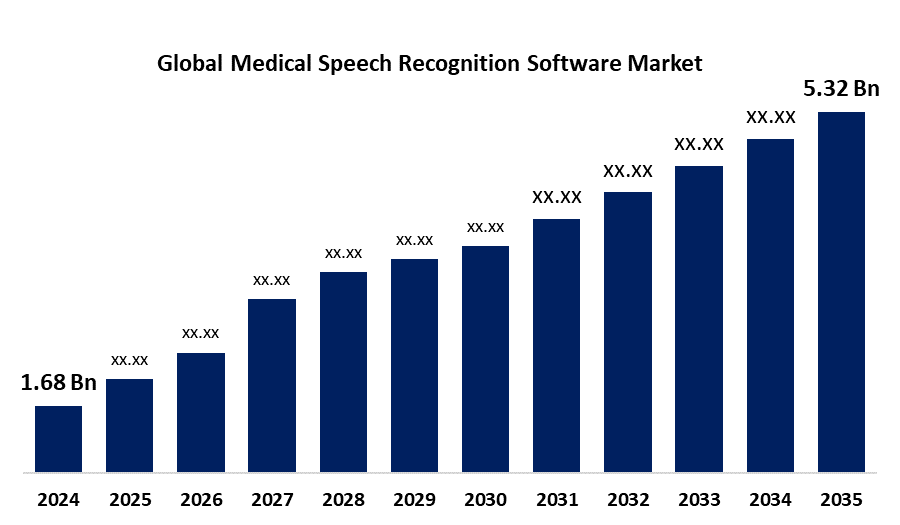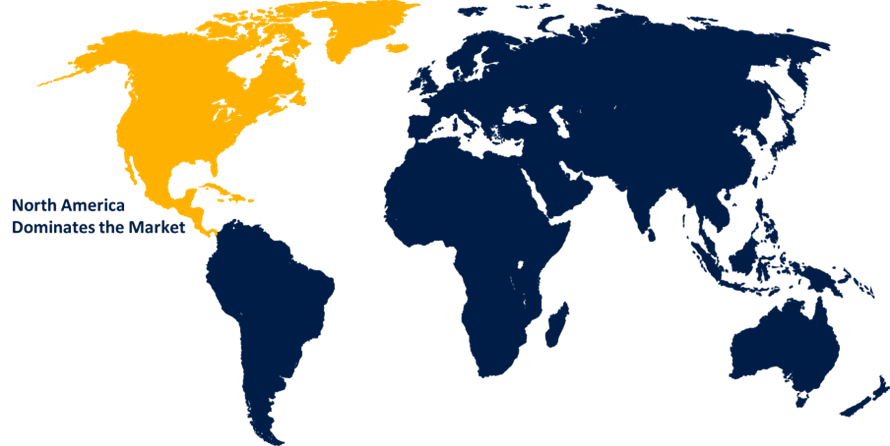Global Medical Speech Recognition Software Market Size, Share, and COVID-19 Impact Analysis, By Deployment (Cloud-based and On-premises), By Functionality (Front-end Speech Recognition, Back-end Speech Recognition, and Voice Command and Control), By End Use (Doctors & Physicians, Radiologists, Medical Transcriptionist, and Others), and By Region (North America, Europe, Asia-Pacific, Latin America, Middle East, and Africa), Analysis and Forecast 2025 - 2035
Industry: HealthcareGlobal Medical Speech Recognition Software Market SizeForecasts to 2035
- The Global Medical Speech Recognition Software Market Size Was Estimated at USD 1.68 Billion in 2024
- The Market Size is Expected to Grow at a CAGR of around 11.05% from 2025 to 2035
- The Worldwide Medical Speech Recognition Software Market Size is Expected to Reach USD 5.32 Billion by 2035
- Asia Pacific is expected to grow the fastest during the forecast period.

Get more details on this report -
The global medical speech recognition software market size was worth around USD 1.68 billion in 2024 and is predicted to grow to around USD 5.32 billion by 2035 with a compound annual growth rate (CAGR) of 11.05% from 2025 to 2035. The market growth is boosted by medical speech recognition software that enhances accuracy, efficiency, and inclusivity in healthcare documentation. These advancements are driving a more streamlined, patient-centered healthcare system.
Market Overview
The medical speech recognition software market refers to a safe, cloud-based application that translates spoken medical language into written text and is intended exclusively for medical professionals. Clinicians may complete documentation more quickly by speaking rather than typing, through its recognition of complicated medical terminology and compliance with healthcare privacy requirements, which set it apart from general-purpose voice assistants.
Through greater investment in health IT infrastructure and smart government efforts, the Asia Pacific region is quickly progressing in healthcare digitalization. A crucial element in improving clinical effectiveness and cutting down on administrative duties is the incorporation of medical voice recognition software. Collaborations are stimulating innovation and helping market players adapt to changing healthcare needs. The region's dedication to the AI-driven healthcare revolution is demonstrated by noteworthy partnerships like those between IBM and DeepScribe.
Report Coverage
This research report categorizes the medical speech recognition software market based on various segments and regions, forecasts revenue growth, and analyzes trends in each submarket. The report analyses the key growth drivers, opportunities, and challenges influencing the medical speech recognition software market. Recent market developments and competitive strategies such as expansion, type launch, development, partnership, merger, and acquisition have been included to draw the competitive landscape in the market. The report strategically identifies and profiles the key market players and analyses their core competencies in each sub-segment of the medical speech recognition software market.
Medical Speech Recognition Software Market Report Coverage
| Report Coverage | Details |
|---|---|
| Base Year: | 2024 |
| Market Size in 2024: | USD 1.68 Billion |
| Forecast Period: | 2025-2035 |
| Forecast Period CAGR 2025-2035 : | 11.05% |
| 2035 Value Projection: | USD 5.32 Billion |
| Historical Data for: | 2020-2023 |
| No. of Pages: | 215 |
| Tables, Charts & Figures: | 120 |
| Segments covered: | By Deployment, By Functionality, By End Use, By Region and COVID-19 Impact Analysis |
| Companies covered:: | Nuance Communications, Inc., S10.AI, Amazon Web Services (AWS), SpeechWrite, 3M Health Information Systems, Lexacom, IBM Watson Health, Dolbey, Microsoft Corporation, The FTW Transcriber, DeepScribe, WebChartMD, Augnito, PrognoCIS, Deepgram, ScienceSoft, Others. |
| Pitfalls & Challenges: | COVID-19 Empact, Challenge, Future, Growth, & Analysis. |
Get more details on this report -
Driving Factors
The conversion of voice inputs into precise, standardized data, medical speech recognition software is transforming healthcare recordkeeping. Particularly for intricate medical vocabulary, the combination of AI and NLP has greatly improved recognition accuracy. Workflows are becoming more efficient and requiring fewer manual data entries through a seamless connection with EHR systems. Clinician satisfaction and documentation speed are increasing because of solutions like Dragon Medical One. Voice-enabled interactions are also encouraging increased diversity and patient participation. Together, these developments make the healthcare system more effective, accessible, and patient-focused.
Restraining Factors
The market growth is hindered by the purchasing this program frequently necessitates a large upfront payment. This covers not just the price of the program but also any required gear, such as compatible computers, dedicated servers, and good microphones. For healthcare workers to use software effectively, extensive training programs are required. Therefore, the market's expansion is hampered by expensive initial installation and training expenses.
Market Segmentation
The medical speech recognition software market share is classified into deployment, functionality, and end use.
- The cloud-based segment held the largest share in 2024 and is anticipated to grow at a significant CAGR during the forecast period.
Based on the deployment, the medical speech recognition software market is classified into cloud-based and on-premises. Among these, the cloud-based segment held the largest share in 2024 and is anticipated to grow at a significant CAGR during the forecast period. The segmental growth can be attributed to the growing need for increased clinical efficiency, cost-effectiveness, and scalability, as well as a greater focus on data accessibility and cooperation. Faster documentation, fewer mistakes, and more time for patient care are all made possible by cloud-based speech recognition software. These solutions increase overall efficiency in healthcare environments and lessen physician burnout by automating documentation duties.
- The front-end speech recognition segment accounted for the largest share in 2024 and is estimated to grow at a remarkable CAGR during the forecast period.
Based on the functionality, the medical speech recognition software market is categorized into front-end speech recognition, back-end speech recognition, and voice command and control. Among these, the front-end speech recognition segment accounted for the largest share in 2024 and is estimated to grow at a remarkable CAGR during the forecast period. The segmental growth can be attributed to real-time transcription of spoken words into text is possible using front-end speech recognition software. For radiologists who must record patient contacts, notes, and other clinical data instantly during patient consultations or operations, this feature is essential.
- The doctors & physicians segment accounted for the largest share in 2024 and is estimated to grow at a remarkable CAGR during the forecast period.
Based on the end use, the medical speech recognition software market is categorized into doctors & physicians, radiologists, medical transcriptionist, and others. Among these, the doctors & physicians segment accounted for the largest share in 2024 and is estimated to grow at a remarkable CAGR during the forecast period. The segmental growth can be attributed to medical voice recognition software, which is being used more and more by doctors and clinicians to improve the accuracy and efficiency of their documentation procedures. The software streamlines paperwork and cuts down on manual data entry time by enabling direct dictation into Electronic Health Records (EHRs). Seamless EHR integration, which reduces errors in medical records and expedites report generation, is one of the main advantages.
Regional Segment Analysis of the Medical Speech Recognition Software Market
- North America (U.S., Canada, Mexico)
- Europe (Germany, France, U.K., Italy, Spain, Rest of Europe)
- Asia-Pacific (China, Japan, India, Rest of APAC)
- South America (Brazil and the Rest of South America)
- The Middle East and Africa (UAE, South Africa, Rest of MEA)
North America is anticipated to hold the largest share of the medical speech recognition software market over the predicted timeframe.

Get more details on this report -
North America is anticipated to hold the largest share of the medical speech recognition software market over the predicted timeframe. The regional growth can be attributed to the changing medical speech recognition as a result of the integration of AI, NLP, and cloud-based solutions, with a focus on data protection and real-time reporting. Leading firms like Cerner, AWS, and Nuance are spearheading innovation suited to radiologists' requirements. Clinical decision-making and data management are being improved by solutions like AWS HealthLake. In the upcoming years, these developments are anticipated to fuel robust market expansion.
Asia Pacific is expected to grow at a rapid CAGR in the medical speech recognition software market during the forecast period. The region's growth is being driven by the rising need for effective documentation. AI-powered solutions are being used by hospitals like Apollo and Samsung Medical Center to increase workflow and accuracy. This rise is further fueled by developments in multilingual support and telemedicine. A focus on compliance and data security guarantees long-term adoption in a variety of healthcare environments.
Competitive Analysis:
The report offers the appropriate analysis of the key organizations/companies involved within the medical speech recognition software market, along with a comparative evaluation primarily based on their type of offering, business overviews, geographic presence, enterprise strategies, segment market share, and SWOT analysis. The report also provides an elaborative analysis focusing on the current news and developments of the companies, which includes type development, innovations, joint ventures, partnerships, mergers & acquisitions, strategic alliances, and others. This allows for the evaluation of the overall competition within the market.
List of Key Companies
- Nuance Communications, Inc.
- S10.AI
- Amazon Web Services (AWS)
- SpeechWrite
- 3M Health Information Systems
- Lexacom
- IBM Watson Health
- Dolbey
- Microsoft Corporation
- The FTW Transcriber
- DeepScribe
- WebChartMD
- Augnito
- PrognoCIS
- Deepgram
- ScienceSoft
- Others.
Key Target Audience
- Market Players
- Investors
- End-users
- Government Authorities
- Consulting And Research Firm
- Venture capitalists
- Value-Added Resellers (VARs)
Key Recent Development
- In August 2024, Nuance Communications, a Microsoft business, announced that Northwestern Medicine has chosen Dragon Ambient eXperience Copilot, which is integrated with Epic, as its ambient voice solution. DAX Copilot, powered by Microsoft Cloud for Healthcare, enables Northwestern Medicine clinicians to turn patient talks into productivity tools, decreasing paperwork loads and improving patient experiences.
Market Segment
This study forecasts revenue at global, regional, and country levels from 2020 to 2035. Spherical Insights has segmented the medical speech recognition software market based on the below-mentioned segments:
Global Medical Speech Recognition Software Market, By Deployment
- Cloud-based
- On-premises
Global Medical Speech Recognition Software Market, By Functionality
- Front-end Speech Recognition
- Back-end Speech Recognition
- Voice Command and Control
Global Medical Speech Recognition Software Market, By End Use
- Doctors & Physicians
- Radiologists
- Medical Transcriptionist
- Others
Global Medical Speech Recognition Software Market, By Regional Analysis
- North America
- US
- Canada
- Mexico
- Europe
- Germany
- UK
- France
- Italy
- Spain
- Russia
- Rest of Europe
- Asia Pacific
- China
- Japan
- India
- South Korea
- Australia
- Rest of Asia Pacific
- South America
- Brazil
- Argentina
- Rest of South America
- Middle East & Africa
- UAE
- Saudi Arabia
- Qatar
- South Africa
- Rest of the Middle East & Africa
Frequently Asked Questions (FAQ)
-
1. What is the CAGR of the medical speech recognition software market over the forecast period?The global medical speech recognition software market is projected to expand at a CAGR of 11.05% during the forecast period.
-
2. What is the market size of the medical speech recognition software market?The global medical speech recognition software market size is expected to grow from USD 1.68 Billion in 2024 to USD 5.32 Billion by 2035, at a CAGR of 11.05% during the forecast period 2025-2035.
-
3. Which region holds the largest share of the medical speech recognition software market?North America is anticipated to hold the largest share of the medical speech recognition software market over the predicted timeframe.
Need help to buy this report?